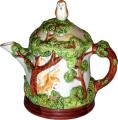The Korean tea ceremony is an ancient tea ceremony that has been practiced for over a thousand years in Korea.
The Korean tea ceremony was inspired by China and preceded the Japanese tea ceremony by several hundred years.
The focus of the Korean tea ceremony is the enjoyment of tea in an easy, formal and natural setting.
History of the Korean tea ceremony
The Korean tea ceremony traditionally has religious overtones. The Korean tea ceremony was traditionally used to revere the spirit of revered persons or ancestors.
The first record of the Korean tea ceremony is from 661AD, when tea was given as an offering to the spirit of King Suro. Later records also show tea offerings were made in Buddhist temples to the spirits of revered monks.
During the Joseon Dynasty (1392-1910), the royal Yi family and aristocracy used tea for simple rites. There was the "Day Tea Rite" which was a common daytime ritual and a "Special Tea Rite" for specific occasions. Towards the end of the dynasty, commoners joined the trend and used tea for ancestral rites.
Equipment used in the Korean tea ceremony
The equipment used in the Korean tea ceremony varies between seasons.
Generally, however, the emphasis is on naturalness in form, emotion and coloring. Most bowls are decorated in a natural style and are made with clay. Some bowl decorations include a bamboo, bark, or pebble appearance.
Summer equipment would include shallow bowls called katade, where hot water would be poured into, before being poured into a teapot.
Autumn and winter equipment consist of taller, narrower bowls called irabo, which are designed to contain and maintain heat. These bowls are typically spiral in shape, with a high rim.
With summer, autumn and winter equipment, the tea cups essentially remain the same. Tea cups used in the Korean tea ceremony have covers that are raised before drinking. This is to hide the open mouth.
Procedure of the Korean tea ceremony
As the Korean tea ceremony places emphasis on ease and naturalness, there are few rules and rituals regarding its procedure. As a result, there is a great deal of variety in the appearance of tea houses, choice of tea, choice of food and the acoustic and visual ambiance of the tea houses.
Water from a local source is generally preferred, and some tea houses had their own springs.
In the Korean tea ceremony, water is boiled over a wood fire, then poured into a teapot and used.
The tea is initially poured into warmed cups, with the teapot held a certain distance above the cup to create bubbles in the tea. The bubbles are said to confer good luck.
Tea used in the Korean tea ceremony
The tea used in the Korean tea ceremony can vary. Historically, Pu-erh tea (an aged tea from China) was used in the Korean tea ceremony.
In modern times, green tea is most often served. Other teas such as Chrysanthemum tea or Persimmon leaf tea may be served at different times of the year. There is an emphasis on fresh tea and new harvests, and aged tea is now rarely used.
Read all about the infamous Japanese tea ceremony.
